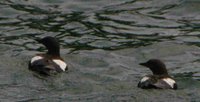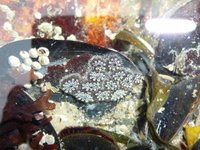 On the second day of the Audubon Leadership Workshop at Hog Island, we took a break to explore the intertidal zone, or as I like to think of it, with over thirty species of invertebrates present, the Maine coast's great bird food larder.
On the second day of the Audubon Leadership Workshop at Hog Island, we took a break to explore the intertidal zone, or as I like to think of it, with over thirty species of invertebrates present, the Maine coast's great bird food larder.Of course, crabs were everywhere. Most were green crabs (Carcinus maenus), and hermit crabs, but we also found one female Asian shore crab (Hemigrapus songuineus) in berry, as well as a few rock crab (Cancer irroratus). These guys are all good food for the many Herring Gulls and Laughing Gulls in the area, and at one point I found three American Crows feeding on the remains of a larger crab. Common Terns also munch on green crabs.
 We also found two kinds of sea star. Here I am showing off my Blood Star (Henricia sp.), and we also found Northern Sea Stars (Asterias vulgaris). While these little guys are savvy hunters themselves, it isn't too uncommon to see gulls eating sea stars as well--especially the larger Glaucous Gull and Great Black-backed Gull. King Eiders also like to eat Asterias sea stars.
We also found two kinds of sea star. Here I am showing off my Blood Star (Henricia sp.), and we also found Northern Sea Stars (Asterias vulgaris). While these little guys are savvy hunters themselves, it isn't too uncommon to see gulls eating sea stars as well--especially the larger Glaucous Gull and Great Black-backed Gull. King Eiders also like to eat Asterias sea stars.One denizen of the shore that was new to me was the clam worm (Nereis sp.), which make a good meal for shorebirds like Black-bellied Plover, Semipalmated Plover, Red Knots, and godwits, as well as gulls and waterfowl like the American Black Duck and Common Eider.
 Of course, everywhere on the rocks we found barnacles, as well as blue mussels (Mytilus edulis) and horse mussels (Modiolus modiolus). These bivalves are the favorite food of the Common Eiders that are so common in Muscongus Bay. The sea ducks dive down and rip these mussels from the rocks, eat them whole, and grind them up in their gizzards, then excrete the shells as crazy blue droppings. Other birds that feast on mussels include American Oystercatcher and Black Scoter.
Of course, everywhere on the rocks we found barnacles, as well as blue mussels (Mytilus edulis) and horse mussels (Modiolus modiolus). These bivalves are the favorite food of the Common Eiders that are so common in Muscongus Bay. The sea ducks dive down and rip these mussels from the rocks, eat them whole, and grind them up in their gizzards, then excrete the shells as crazy blue droppings. Other birds that feast on mussels include American Oystercatcher and Black Scoter. Rock eels (Pholis gunnellus) are the favorite food of the other most common Muscongus Bay bird--the Black Guillemot. We found a couple of these long fish--actually a gunnels--under rocks in the tide pools. The guillemots dive down and chase these fish among the rocks under water--a sight I'd love to see. Other birds that hunt these gunnels include Double-crested Cormorant, Great Cormorant, and Red-throated Loon.
Rock eels (Pholis gunnellus) are the favorite food of the other most common Muscongus Bay bird--the Black Guillemot. We found a couple of these long fish--actually a gunnels--under rocks in the tide pools. The guillemots dive down and chase these fish among the rocks under water--a sight I'd love to see. Other birds that hunt these gunnels include Double-crested Cormorant, Great Cormorant, and Red-throated Loon. My favorite animal of the day was probably the golden star tunicate (Botryllus schlasseri). We also found Sea Pork (Amaroucium stellatum) and white crusts (Didemnum sp.). I have to admit I've never seen a tunicate before, and I was quite taken by these strange little animals. The golden star tunicates are introduced from Europe, and I have no idea if any birds actually eat these little colonies since they are rather firmly attached to the rocks, but they are quite pretty and its possible that the free-swimming forms may be eaten by birds at sea.
My favorite animal of the day was probably the golden star tunicate (Botryllus schlasseri). We also found Sea Pork (Amaroucium stellatum) and white crusts (Didemnum sp.). I have to admit I've never seen a tunicate before, and I was quite taken by these strange little animals. The golden star tunicates are introduced from Europe, and I have no idea if any birds actually eat these little colonies since they are rather firmly attached to the rocks, but they are quite pretty and its possible that the free-swimming forms may be eaten by birds at sea.Snails were common in the tide pools, especially the common periwinkles (Littorina littorea) and dog whelks (Nucella lapillus). We also found some of the smaller smooth or northern periwinkle (Littorina obtusata) and a few tortoise shell limpets (Acmaea testudinalis). Dozens of bird species eat periwinkles, including shorebirds like Purple Sandpipers and Ruddy Turnstones, and ducks like Common Goldeneyes, scoters, and Long-tailed Duck. Limpets may take a little more work to pry off of rocks, but some do get pulled off by eiders and oystercatchers.
Other bird food we found included beach fleas (Orchestia sp.), blood worms (Glycera sp.), and my favorite the twelve scaled worm (Lepidonotus sp.). Amphipods included the North Atlantic scud (Gammarus oceanicus) swimming sideways under rocks, where they seek refuge from the dozens of birds that eat them--pretty much any shorebird, seabird, or sea duck in the area.
 After checking out the littoral bird food, we waded out to do some sceining. This brought in lots of three spined sticklebacks (Gasterosteus aculeatus), Atlantic silversides (Menidia menidia), bent mysids (Praunus flexuosus), and grass shrimp (Hippolyte sp.). Common Terns frequently take all of these species, as do many other species feeding in shallow water--including Snowy Egret and Brown Pelican. We also managed a medium sized sculpin (Cottidae sp.)--a fish favored by loons, mergansers, cormorants, and even Great Black-backed Gulls.
After checking out the littoral bird food, we waded out to do some sceining. This brought in lots of three spined sticklebacks (Gasterosteus aculeatus), Atlantic silversides (Menidia menidia), bent mysids (Praunus flexuosus), and grass shrimp (Hippolyte sp.). Common Terns frequently take all of these species, as do many other species feeding in shallow water--including Snowy Egret and Brown Pelican. We also managed a medium sized sculpin (Cottidae sp.)--a fish favored by loons, mergansers, cormorants, and even Great Black-backed Gulls.  After a couple hours of exploration, it was clear that the world is a marvelous place full of strange creatures...and that there is a lot for birds to eat where water meets shore.
After a couple hours of exploration, it was clear that the world is a marvelous place full of strange creatures...and that there is a lot for birds to eat where water meets shore.




1 comment:
Thank you very much for this blog post!
I was especially intrigued by the photo of the Loon - inspiring!
All the Best
Post a Comment